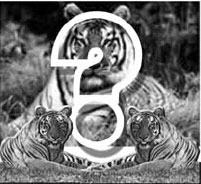Shift focus on South China tiger
Updated: 2007-11-29 07:22
Most people believed the controversy over the genuineness of the photograph of a South China tiger had been settled early this month when the State Forestry Administration spokesman Cao Qingyao announced that his administration would gather specialists together to conduct a field research in Zhenping County, Northwest China's Shaanxi Province.

The administration took a right approach to the matter without giving its verdict, even though many netizens pointed out that the photograph was actually a fake. The tiger in the photograph had the posture and facial expression similar to that depicted in a traditional Chinese painting.
However, the dust was stirred up again last Friday, when the local forestry bureau released what it said to be 71 more photographs to prove that the controversial one was real, and thus there was indeed a South China tiger - or even eight more - in Zhenping.
Zhenping County, covered by more than 1,200 sq km of forests, may be a haven for a variety of wildlife. Until two years ago, about 70 to 80 local people were licensed hunters, while 600 to 700 took to hunting on the side. The licensed hunters claimed that they made more than 10,000 yuan ($1,315) every year then. Today, they make only half of that tilling their farmlands.
The local farmers always believed tigers existed in the forests, and local history annals record appearances of the South China tiger. More than 20 years ago, Zhenping farmers reported the sighting of a tiger.
Between 1999 and 2001, the State Forestry Administration carried out an extensive field search in six provinces in the eastern and southern part of China as well as in Shaanxi. The experts did find pugmarks, droppings or hairs that tigers might have left, but none of them actually sighted one.
Thus, the media became interested when a Zhenping farmer announced to the public he had chanced upon a tiger and taken about 70 photographs, after having roamed the mountains for some 40 days.
Despite local "official and scientific" authentication of two photographs, which were carried by most of the newspapers and websites on the Internet, other scientists raised doubts.
One scientist, familiar with the local flora and fauna as he once trekked in the forest for research, said the size of a leaf over the tiger's forehead gave the photograph away.
"The size of the leaf is very big and no such plant has as big a leaf as the one in the photo," the scientist was quoted as saying.

So there is really no point for the local forestry bureau to argue its case by coming up with 71 more photographs. A colleague of mine was right in saying that 710 more similar photographs would not provide the hard evidence as to whether South China tigers roam Zhenping.
Some journalists have actually discovered that money was behind the retired hunters' enthusiasm for taking the photographs, as they were told last year someone would pay for photographs of tigers.
The money on offer has naturally made people suspicious of the authenticity of the photographs, since the retired hunter has not been able to provide more proof - droppings, hairs or pugmarks - to further verify his "discovery".
Above all, there is no point simply arguing over the photographs. The right thing to do is to have biologists and zoologists go into the forests and give them time and financial support to conduct genuine research there.
The research should focus on learning about the biodiversity of the area, and record the number and species of wildlife. Whether there is a tiger or not, the forests along with the wildlife should be preserved.
E-mail: lixing@chinadaily.com.cn
(China Daily 11/29/2007 page10)
|
|
|
|
|
|